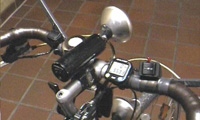Accept
Details & settings
This website uses cookies for cookie consent and statistics.

Cyclists are amongst the most vulnerable road users. Their recognizability is of prime importance for their safety as many accidents result from cyclists being overlooked or spotted too late. Therefore, the bicycle lighting system is particularly important, however, the systems that are currently available have several weaknesses. Apart from safety deficiencies, the standard lighting system consisting of a bottle dynamo and two incandescent light bulbs is also exhausting for the cyclist due to its low energy efficiency. Its operation is impractical as the light is switched on and off at the bottle dynamo, which is out of reach while cycling. Safety issues result from the low brightness of the lights at low speeds and the absence of lights when the bike is stationary. Solutions for these safety issues are offered by lights that include a capacitor and by battery operated systems. However, capacitor lights only last a few minutes, which can be problematic at railway crossings and roadworks. Battery operated lights last fairly long, but they either need replacement batteries or they need to be charged at an electrical socket. Of course, one could plan ahead and charge the batteries in advance, but who does actually remember to do this?
On the background of this disappointing situation, I decided to develop a lighting system that avoids the above-mentioned problems and that offers additional advantages:
The key components of my lighting system are a hub dynamo, a lithium ion battery and bright, efficient lights based on LEDs. My system does not require the cyclist to work harder as the required electrical energy is generated when the cyclist brakes, the hub dynamo is switched on during every brake application, the AC voltage is converted to DC voltage and the battery is charged. Continuous charging of the battery is also possible via a switch on the handlebars. As the resistance of the hub dynamo is very low, charging while cycling in the plane or downhill requires very little effort. The main advantage of a battery that is charged while cycling is a reliable electricity supply, which can be used for applications beyond standard bicycle lights, particularly lighting that is independent of movement, turn indicators and a brake light, all of which offer substantial safety benefits.